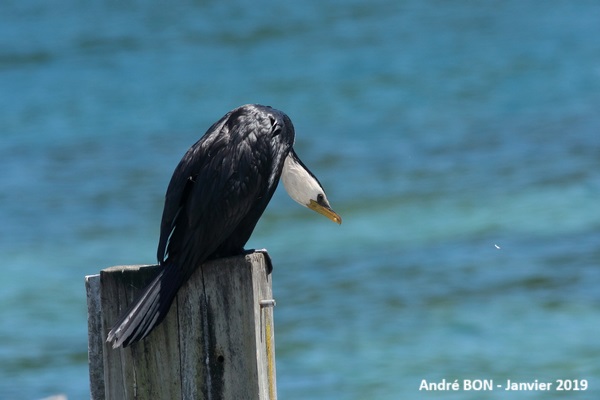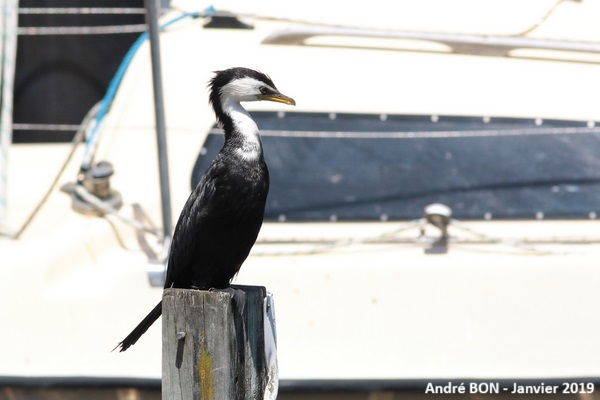



| Little Pied Cormorant (Microcarbo melanoleucos (Vieillot, 1817)) |




|
|
Scientific name: Microcarbo melanoleucos (Vieillot, 1817) Common name: Little Pied Cormorant Other names: Little Cormorant, Little Shag. Maori name: Kawaupaka. French name: Cormoran pie Order: Suliformes Family: Phalacrocoracidae Size: Body size: 55 to 65 cm; Wingspan: 84 to 91 cm; Weight: 420 to 900 g. Habitat: Mainly in fresh water on lakes, ponds, rivers and other small bodies of water, even artificial ones. It is also observed along the seaside in estuaries, lagoons, mangroves, salt marshes, etc. It has a preference for habitats with shallow water and bordered by trees or bushes. Food: Fish, crustaceans and aquatic insects. Nesting: The Little Pied Cormorant nests in small colonies, often in the company of other species of Cormorants, Herons and other aquatic bird species. The nest is a small platform located in a tree, bush or occasionally on the ground. There are 3 to 5 eggs per clutch. Migration: Sedentary with some local movements depending on fluctuations in water bodies. Geographic area: There are 3 subspecies. Microcarbo melanoleucos melanoleucos is found in eastern Indonesia, Papua New Guinea, the Solomon Islands, New Caledonia, Australia and Tasmania. Microcarbo melanoleucos brevicauda is found on Rennel Island and south of the Solomon Islands. Microcarbo melanoleucos brevirostris is found in New Zealand, on Stewart Island and on the sub-Antarctic islands. |
The Little Pied Cormorant is much smaller than other Cormorants. The top of the head, neck and body, wings and tail are shiny black and greyish black. There are green highlights on the wings. During the breeding season, the top of the head bears a small crest of ruffled feathers. There is a white line above the eye. The cheeks, sides of the neck and throat are white. The bill is short, black above and yellow below. The grey-blue eyes are surrounded by an area of blackish bare skin. The tail is quite long. The legs are black. The underside of the melanoleucos and brevicauda subspecies is white with traces of brownish orange. The brevirostris subspecies is polymorphic. A quarter of the individuals are similar to the other subspecies, the remaining three quarters are a dark morph with black underside. There are intermediate individuals with spotted underparts. The plumage of juveniles is duller and the crown extends below the eye. Juveniles of the dark morph are completely black. The Little Black Cormorant (Phalacrocorax sulcirostris), which is also a small size, has a greyish and longer bill. The tail is shorter. |
| [To know more about the Little Pied Cormorant] [Next picture] [Top] |

|
Here we have the dark form with the black belly. The tail is quite long and my framing is not very good as it extends out of the photo. |
| [To know more about the Little Pied Cormorant] [Next picture] [Previous picture] [Top] |

|
The small ruffled crest is slightly visible on the front of the top of the head. |
| [To know more about the Little Pied Cormorant] [Next picture] [Previous picture] [Top] |

|
Prey in sight? |
| [To know more about the Little Pied Cormorant] [Previous picture] [Top] |

|
This Little Pied Cormorant, not very shy, allowed me to photograph it in the port of Taupo. |